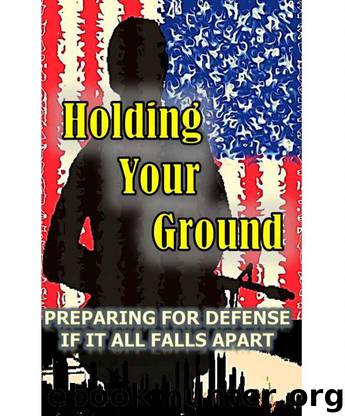Holding Your Ground: Preparing for Defense if it all Falls Apart by Nobody Joe

Author:Nobody, Joe [Nobody, Joe]
Language: eng
Format: mobi, epub
Publisher: Kemah Bay Marketing LTD.
Published: 2011-06-06T04:00:00+00:00
Figure 34 - Cutaway Showing Slope and Height of Position
As you can see in Figure 34, the more elevation your location has above surrounding land, the higher your bullet stop (B) needs to be. You must maintain your angle of fire (A).
The best method to compute height is to use a measuring tape to simply go try it. Pick your spot, get into a comfortable firing position and measure it.
7.12.3 Stopping Lead
Cover is the primary purpose of creating fighting positions. Stopping high velocity lead without using our body is the goal. With a little knowledge, creativity and planning, this can be accomplished using several different methods.
As stated above, walls do not stop bullets, so we have to reinforce our fighting positions for protection.
I have read several web sites that contain plans for “ballistic plywood”, “fiberglass bullet shields” and other techniques for establishing a bullet stop around your fighting position. One television show even used phone books as armor plating and it worked…somewhat. I have never tried any of these because I don’t feel they are practical. If you feel confident about these methods, it may be a good solution for your location.
If you have ever heard the phrase “cheaper than dirt”, it will take on a whole new meaning as you begin to develop cover (bullet stops). Good old dirt (or sand) is probably the absolute best material to consider when creating any sort of cover.
The sandbag is the simplest method to “contain” or “provide structure for” dirt.
The military uses sandbags for bullet stops or to reinforce fighting positions. Good enough for them, good enough for me. Sandbags have several advantages:
- They are portable. You don’t have to ruin the interior of your house making a bullet shield. If the event occurs, then you can mess up your wife’s dining room.
- They are repairable. It one gets ripped or torn, just apply duct tape.
- Sand makes a great fire extinguisher.
- Sand bags make a great rifle rest.
And the most logical reason of all:
THEY ARE DIRT CHEAP!
There is actually a recommended way to stack sand bags, but I really don’t think it makes much difference.
A 5.56 NATO round (AR15), will penetrate about 10 inches of sand. A 7.62 x 51 round (.308) will penetrate about 12 inches of sand. The actual penetration depends on the type of round, distance from the target, humidity and wind. The numbers above are just averages and even if the round does go all the way through the sandbag, most of its energy will be depleted.
We don’t have to use sand “bags”, or even sand. Gravel (fine) or dirt will do just fine as a bullet stop and virtually any sort of “container” will work.
I have a problem window at my BOL that is perfect for observation, but is going to be a difficult to reinforce. It is in a niche that just won’t work for stacking sandbags. There is a typical old wooden dresser not far away, so I plan to empty the drawers, move it in front of the window and then fill each drawer with sand and put it back in the dresser.
Download
Holding Your Ground: Preparing for Defense if it all Falls Apart by Nobody Joe.epub
This site does not store any files on its server. We only index and link to content provided by other sites. Please contact the content providers to delete copyright contents if any and email us, we'll remove relevant links or contents immediately.
Man-made Catastrophes and Risk Information Concealment by Dmitry Chernov & Didier Sornette(5956)
The Revenge of Geography: What the Map Tells Us About Coming Conflicts and the Battle Against Fate by Kaplan Robert D(4052)
Zero Waste Home by Bea Johnson(3805)
COSMOS by Carl Sagan(3589)
Good by S. Walden(3521)
In a Sunburned Country by Bill Bryson(3508)
The Fate of Rome: Climate, Disease, and the End of an Empire (The Princeton History of the Ancient World) by Kyle Harper(3033)
A Wilder Time by William E. Glassley(2835)
Camino Island by John Grisham(2778)
Organic Mushroom Farming and Mycoremediation by Tradd Cotter(2661)
The Ogre by Doug Scott(2657)
Human Dynamics Research in Smart and Connected Communities by Shih-Lung Shaw & Daniel Sui(2479)
Energy Myths and Realities by Vaclav Smil(2463)
The Traveler's Gift by Andy Andrews(2436)
9781803241661-PYTHON FOR ARCGIS PRO by Unknown(2343)
Inside the Middle East by Avi Melamed(2328)
Birds of New Guinea by Pratt Thane K.; Beehler Bruce M.; Anderton John C(2237)
A History of Warfare by John Keegan(2214)
And the Band Played On by Randy Shilts(2166)
